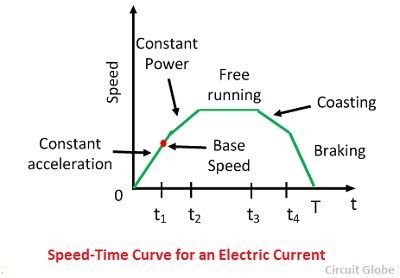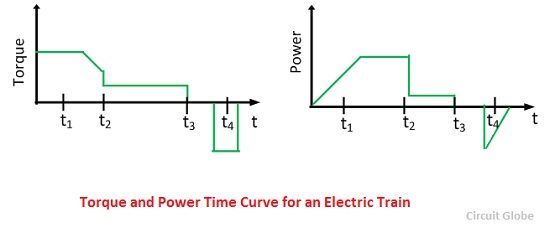Definition: The drive which uses the electric power for moving forward, such type of drive is called an electric traction drive. One of the major application of an electric drive is to transport men and materials from one place to another. The traction drives are mainly classified into two types, i.e., the single phase AC traction drive and the DC traction drive.
Electric Traction Services
The electric traction services can be broadly classified as
- Electric trains
- Main-Line Trains
- Suburban Trains
- Electric buses, trams and trolleys.
- Battery and solar powered vehicles
The electric traction services are explained below in details.
1. Electric Trains
The electric train run on fixed rails is further classified as main line train and suburban train.
Main-Line Trains – In such type of train the power supplies to the motor in two ways, i.e., either from an overhead line in an electric locomotive or through diesel generator set in a diesel locomotive.
In electrical locomotive, the driving motor is placed in the locomotive. The overhead transmission line is laid along or above the rail. The current collector is attached over the locomotive has conductor strip which slides against the supply conductor. Thus, maintain the contact between the supply and the locomotive.The supply conductor is normally known as contact wire. For ensuring the good contact between the current collector and supply wire the catenary cable and dropper wires are used.
In the high-speed train, the pantograph collector is used. The collector has the shape of a pentagon and hence it is called pantograph collector. The collector has the conducting strip, which is pressed against the contact wire by springs.The collector strip is usually made of steel, and it maintains the constant pressure between the collector strip and the contact wire for preventing vertical oscillations.
The single phase supply is laid all along the track, and the current enters into the locomotive through the collector.The power enters through the primary of the step-down transformer and returns to supply earth through locomotive wheels.The secondary of the power transformer feeds the power modulator which in turns power the driving motor. The secondary of the transformer also supply power for a lightning fan, air conditioning, etc.
Suburban Trains – The suburban trains are used for travelling at small distances. This train is also known as the local train.The suburban train has a consecutive stop at a much smaller distance. This train consists motorised coaches for increasing the ratio of the weight on driving wheels and a total weight of the train due to which the acceleration and de-acceleration of the train increase.
The each motor coach is equipped with electric drive and pantograph collector. The usual pattern for using the power and unmotorised coaches is in the ratio of 1:2. For high powered train, the ratio may be increased from 1:1. The train which uses motorise coach and trailer coach is also known as electrical multiple unit (EMU) train.The power supply for the suburban train is similar to that of the main train except in an underground train.
In the underground train, the DC supply is used because the DC supply system required lesser clearance from the supply conductor of the train body. Also, the power modulator becomes simpler and less expensive. The underground trains do not use the overhead transmission line, and hence the power is supplied from the running rails or on one side of the tunnel.
2. Electric Buses, Trams and Trolleys
Such type of drive usually consists single motor driven coach. It takes the supply from the low-voltage DC overhead line which is running along the roadside. As the current is generally small, the collector consists of a rod carrying at its end a grooved wheel or two rods bridged by a contact bow.The collector system is provided with enough flexibility, and it also provided an additional conductor for the return of current.
The trams are electric buses which run on rails, and it consists a single motor coach. Sometimes, two or more unmotorised or trailer coaches are added. Their current collection system is similar to buses, and its return can be through one of the rails. The trams run on rails, and their path through road is fixed.
Electric trolleys are used for transporting material in mines and factories. It is mostly run on rails. They are similar to trams; only the shape is different.
Important Features of electric traction drives
The important features of the electric traction drives are explained below.
- The traction drive required large torque during start and acceleration to accelerate the heavy mass.
- Because of economic reason single phase supply is used in AC traction.
- The supply has sharp voltage fluctuations, including discontinuity when the locomotive crosses from one supply section to another.
- The harmonics injected into the source, both in AC and DC traction can cause interference in telephone lines and signals.
- Traction drive mainly used dynamic braking. A mechanical brake is also used when the drive is stationary.
Duty Cycle of an electricTraction Drives
The duty cycle of traction drive is explained below with the help of speed-time curve and power torque time diagram. Consider the drive travel between two consecutive stations on a level track. The train is accelerated at the maximum possible torque, and the power increases linearly with speed.
At time t1 the base speed and the maximum allowable power is reached. Further acceleration occurs at constant power.The torque and acceleration decrease with speed. At time t2 the drive torque equal to the load torque, and steady speed is reached. The acceleration 0 to t2 has two parts. From 0 to t1 the acceleration has constant torque, and at t1 to t2 the acceleration has constant power.
From t2 and t3 train runs at a constant speed and constant drive power. This duration is known as free running. At the suitable time t4, the brake is applied to stop the train at the next station.






Thank u
Thank you for presenting this exceptionally well-written blog. You have explained your points in so simplified manner that it is very easy to understand for everybody. I was looking for learning more about these electric traction drives, your article is helpful!
Hey thanks for posting this useful tips here, I really hope it will be helpful to many… It will help a lot; these types of content should get appreciated. I will bookmark your site; I hope to read more such informative contents in future. Appreciative content!!